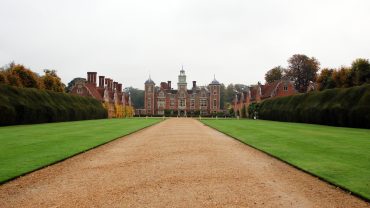Warehouse conversions in the UK are often regarded as the epitome of contemporary urban living. Yet, their true allure lies in the unique blend of historic character and modern design – where original features such as exposed brickwork and cast-iron columns meet sleek, innovative interiors. This seamless fusion of old and new is what makes warehouse flats in London and elsewhere in the country so sought after by today’s discerning homebuyers.
In this article, we’ll tell the story of warehouse-to-home transformations in Britain, as well as looking at some of the most famous British warehouse conversions. Let’s unpack the past and see how these spaces were re-stored to glory.
The History of British Warehouse Conversions

Goods from all over the world arrived in London's warehouses (Credit: duncan1890 via Getty Images)
The imposing brick warehouses that line the Thames and other British waterways were largely constructed during the nineteenth century, as Britain’s industrial strength reached its peak. These vast structures, built from the early 1800s onwards, were designed to store a dizzying array of goods, including tobacco, grain, tea, coffee, fruit, meat, and textiles, arriving by ship from all over the world. Their strategic locations beside docks and quays made them essential to the efficient movement of goods, with cranes and barges operating day and night to keep the nation’s commerce flowing.
As new manufacturing techniques took hold, cities saw a surge in the construction of vast warehouses to store goods and house increasingly complex machinery. Landmark industrial districts emerged – from London’s bustling riverside and Manchester’s cotton mills, to Glasgow’s Merchant City, Liverpool’s Albert Dock, and the harbourside warehouses of Bristol – each a testament to the era’s rapid economic growth, and the future locations for some of the most impressive warehouse conversions in the UK.
The Waning Warehouses

By the 1980s, many of London's Thameside warehouses were derelict (Credit: Gregory Warran via Getty Images)
For more than a century, these warehouses thrived as the backbone of Britain’s trade infrastructure. However, by the mid-twentieth century, the advent of containerisation, larger ships, and new deep-water docks rendered many of these riverside warehouses obsolete. The decline accelerated after World War II, as bomb damage, industrial disputes, and shifting global trade patterns took their toll. By the early 1980s, the last commercial vessels had shipped out, leaving behind a landscape of derelict buildings and economic hardship.
In the years between their commercial heyday and the astonishing warehouse-to-home transformations, most stood empty, effectively being left to become modern ruins. Some found fleeting new purposes as informal studios for musicians or canvases for street artists, but most simply lingered as reminders of a bygone age.
It was in this period of uncertainty that architects, developers, and local visionaries began to see the potential for a new kind of urban living. The idea of warehouse conversions in the UK – into apartments, studios, restaurants, bars and gallery spaces – first gained traction in the late 1970s and early 1980s, but how did vast areas of derelict land and dangerously decrepit buildings become some of the country’s most desirable properties?
New Beginnings: The (High) Rise of Warehouse Flats in London

Butler's Wharf has been converted in apartments, shops and restaurants (Credit: shomos uddin via Getty Images)
During the 1980s and 1990s, London’s riverside landscape underwent a dramatic transformation as former industrial and dockside warehouses along the Thames were converted into striking residential and commercial spaces. This wave of regeneration was largely prompted by the decline of the Port of London, which saw dock closures and left many warehouses redundant and derelict. In response, policy initiatives such as the creation of the London Docklands Development Corporation (LDDC) helped drive investment and redevelopment in these once-neglected areas.
The surge in demand for unique warehouse-to-home transformations in Britain, especially in London, played a key role in this shift, with the riverfront’s historic architecture and sweeping views proving irresistible to new residents. These conversions quickly became synonymous with ‘loft living,’ characterised by original features like exposed brickwork, cast iron columns, open-plan layouts, and dramatic mezzanine levels. Today, areas such as Butler’s Wharf and Tea Trade Wharf in Shad Thames, as well as Wapping’s riverside, are celebrated for their blend of industrial heritage and modern luxury, prime examples of how London’s past has been stylishly reimagined for contemporary life.
There are many examples of famous British warehouse conversions, including the Bermondsey Warehouse Loft, Port East Apartments in Canary Wharf, and Clapton Warehouse and Florida Street in Bethnal Green. Other significant projects included unique live-work spaces including those found in Broad Court near Covent Garden, and Lea Park Workshop in Leyton. These conversions set the standard for loft living in London, making them popular with professionals and creatives seeking a blend of history, space, and urban style.
The development in London started a wave of British warehouse conversions in other urban centres, particularly where former docklands or industrial zones met shifting economic priorities.
Expansion: Warehouse Conversions across the UK

Warehouse conversions are desirable places to live (Credit: JohnnyGreig via Getty Images)
The conversions along the Thames significantly influenced urban regeneration, soon sparking a host of warehouse-to-home transformations in Britain. Projects in Liverpool, Manchester, Bristol, and Glasgow adopted similar styles and approaches, proving that London’s transformation of industrial riverfronts had a powerful and lasting ripple effect.
Albert Dock, Liverpool’s Centre of Culture & Creativity

Albert Dock's waterfront regeneration (Credit: Atlantide Phototravel via Getty Images)
The Albert Dock in Liverpool stands as one of the UK’s most celebrated examples of waterfront regeneration, closely mirroring the transformation seen along London’s Thames. Opened in 1846, the dock was once a symbol of Liverpool’s maritime dominance, but by the 1970s advances in shipping technology and the shift to containerisation had rendered its warehouses obsolete. The entire complex fell into dereliction until the early 1980s when regeneration became a civic priority, and the warehouse conversions started in the middle of that decade.
The ambitious redevelopment of the Albert Dock was spearheaded by the Merseyside Development Corporation (MDC) which was established in 1981. Working in partnership with private developers, the MDC oversaw the restoration of the Grade I listed warehouses, converting them into a vibrant mix of museums, restaurants, galleries, and apartments. The reopening of the dock in 1988, marked by the launch of Tate Liverpool and the Merseyside Maritime Museum, signalled a new era for the city. The project not only preserved Liverpool’s architectural heritage but also set a benchmark for urban regeneration in the North, becoming a flagship counterpart to London’s Docklands revival.
Manchester’s Canal-Side Warehouse Conversions

The transformation of Castlefield has been remarkable (Credit: Eric Latham via Getty Images)
Manchester’s transformation from industrial powerhouse to creative hub is vividly illustrated by some of the most dramatic warehouse-to-home transformations in Britain, particularly in areas like Castlefield and Ancoats. Once dominated by bustling mills and factories, these canal-side districts have been reimagined as vibrant residential and commercial communities, echoing the city’s rich industrial heritage. In Castlefield, some of the earliest and most striking conversions, such as Middle Warehouse and Merchants Warehouse, set the tone for the area’s regeneration. These early nineteenth century buildings were restored with a keen eye for original features including exposed brickwork, cast iron columns, timber beams, and open-plan layouts.
Ancoats, once the heart of Manchester’s textile industry, has also seen a wave of development. Projects like Brooklyn Lofts and the ambitious redevelopment of Royal Mills are among the most famous British warehouse conversions, and have breathed new life into former factories, turning them into sought-after apartments and creative hubs.
Bristol’s Warehouse Transformations

The warehouse conversions on Bristol's Harbourside (Credit: GordonBellPhotography via Getty Images)
Bristol’s Harbourside and Redcliffe districts have seen a remarkable revival, echoing the development of warehouse flats in London and Liverpool. Once vital to the city’s maritime trade, the redundant warehouses lining the Floating Harbour were gradually transformed from the 1980s onwards into stylish apartments and modern office spaces. This regeneration breathed new life into the area, attracting residents and businesses drawn to the unique blend of history and contemporary living.
The warehouse conversion projects in Bristol have been careful to retain the original maritime and industrial character of buildings including Huller House and the Cheese Factory.
From Derelict to Desirable in Glasgow

Glasgow's warehouse transformations (Credit: Westend61 via Getty Images)
Glasgow’s Merchant City district underwent a dramatic transformation in the 1980s, when its grand Victorian warehouses were converted into stylish apartments, boutiques, and cafes. This regeneration catered to a growing demand for centrally located, character-rich housing among professionals and creatives.
Key projects, such as Ingram Square and the Italian Centre, turned once-derelict warehouse blocks into vibrant residential courtyards and mixed-use spaces, preserving original architectural features while introducing modern comforts. The conversion style retained the robust brickwork and generous proportions of the original warehouses, blending Glasgow’s industrial heritage with contemporary urban living and transforming one of the city’s most run-down areas into one of its most desirable.
History Meets Home: Warehouse Conversions in the UK

Surrey Quays and Canary Wharf in London's Docklands (Credit: Richard Newstead via Getty Images)
The most famous British warehouse conversions have transformed forgotten industrial relics into some of the country’s most sought after places to live and work. By blending historic character with contemporary design, these projects have not only preserved architectural heritage but also revitalised entire neighbourhoods, creating vibrant new communities along riversides and city centres and reimagining the past for modern life.











